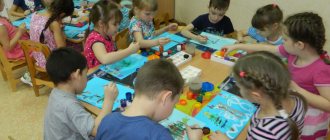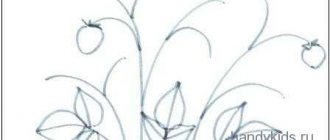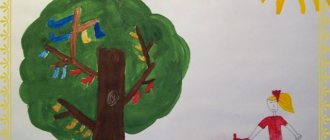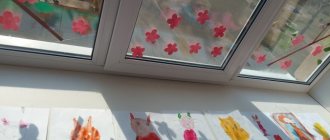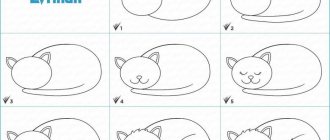Planning drawing lessons on the topic “Transport”
In the senior group, standard long-term planning provides for one drawing lesson per week. The total duration of continuous activity should not exceed 20–25 minutes. Methodological manuals recommend performing physical exercises (finger, breathing, motor exercises) for 5 minutes for relaxation and prevention of mental and physical fatigue in children.
Lesson outline:
- Organizational part - includes an educational or playful conversation of a motivating nature, which is accompanied by demonstration of visual material, reading poems and riddles, listening to a fragment of a musical or literary work, stimulating the activity of children and setting them up to work with a specific subject image (approximately 3-5 minutes).
- Practical part - the teacher explains the sequence of drawing parts after examining the object (3-5 minutes). Older preschoolers are given more freedom in the drawing process; the sample is used, as a rule, only in decorative drawing. A picture or sample prepared by the teacher should not be used for copying, but only to form a correct understanding of the task or clarify it. The work is done from life or on the basis of life experience and observation; the basic techniques have already been mastered, and therefore do not require additional demonstration, with the exception of the initial use of new material, for example, sanguine.
- Independent work of children (15–20 minutes).
Setting up a demonstration stand will help children imagine their future work. - The final part - a comparison of children's images with the object is made, the degree of similarity between the original and the artistic copy is assessed (3 minutes).
Table: didactic games for classes on the topic “Bus” (“Urban transport on our street”, author E. R. Fedotova)
| A game | Content |
| "The Fourth Wheel" | The teacher asks the children to identify the extra word in the series and explain why it is extra. - Tram, bus, plane, trolleybus. (The word “plane” is superfluous, because this is an air mode of transport, and the rest are land-based) - Boat, helicopter, cutter, liner. (The word “helicopter” is superfluous, because this is an air mode of transport, and the rest are water-based) - Yacht, steamship, fire engine, ship (The word “fire engine” is superfluous, because this is a special transport, and the rest are water-based) |
| "Fix the problem" | — We ended up in a repair shop. There are a lot of broken vehicles here! Do you want to renovate? (Children complete the pictures of transport with the missing parts, then make up a sentence about what they did: “I repaired the bus,” similarly for the rest) |
| Dynamic pause “Traffic signals” | The teacher shows the children colored paper circles. If the circle is red, the children squat; if the circle is yellow, they stand up; if the circle is green, they walk in place. |
| "Ride the Bus" | Educator: Guys, a bus is waiting for us at the stop, but for it to go, we need a driver. Now we will choose a driver according to the counting rhyme. - We're going to play, well, who should start? One, two, three, you begin. — What does a driver need to drive a bus? (children's answers). - Get behind the wheel, driver, and take the passengers. — What are the names of the people who travel on the bus? (Passengers) Educator: Who should be allowed through when entering the bus? (Children's answers.) Please, passengers, take your seats. - Who else is on the bus? (Children's answers.) - When passengers ride on a bus, the conductor sells tickets. I will be the conductor (the teacher has a conductor’s bag). We have a magic bus in which tickets are issued for polite words (the conductor issues tickets for polite words). |
| "It is possible - it is not possible" | — Let's remember the rules of conduct for passengers on public transport. Answer whether it is possible or not:
|
| Finger gymnastics “Transport” | (As we read the poem, we bend our fingers one by one) The first finger, the baby, and I will go to the tram park on foot. With the other, we will go on a tram, quietly humming songs. The third and I will get into a taxi and ask them to take us to the port! With the fourth finger in the rocket We will fly to another planet. Come on, number five, get on the plane, we’ll go flying with you. Conductor: Passengers, be careful, the bus is approaching the stop, get ready to get off. — How should you get off the bus? (children's answers). What should you do with your tickets after traveling on the bus? (Children throw tickets into the trash can next to the bus stop) Educator: Guys, there is a pedestrian crossing in front of us. Take your time, look left, right. Let's calmly walk through the pedestrian crossing. (Children walk along the pedestrian crossing). |
Photo gallery: demonstration material for a lesson on the topic “Bus”
The didactic game “Name it Correctly” helps develop thinking
Didactic game "The Fourth Odd" trains logic
Sidewalk rules can be explained in a playful way
Rules for crossing the road - the basis of traffic rules for children
Table: summary of a lesson in drawing with colored pencils on the topic “Bus decorated with flags” (author V. G. Bozhko)
| Topic: “Bus decorated with flags” | |
| Tasks |
|
| Handout |
|
| Organizational part | - Now I will show you pictures of transport, and you will say the name of this transport. (We show and the children name). Well done. Now let's remember the types of transport. What type of transport is a ship? (Water). - Why? (Because he floats on water). - Well done. Bus, tram and trolleybus - what type of transport is this? (Terrestrial because it moves on the ground). - Fine. What type of transport is an airplane and a helicopter? (Aerial because they fly through the air). - Right. Today we will draw a representative of the ground class - a bus. I brought you a bus today, let’s look at it and touch it. Name the main parts of the bus. (Wheels, windows, doors, headlights). - Fine. Why does a bus need windows? (So that people can see where they are going). — Why does the bus need doors? (To board and disembark passengers at stops). - That's right, why does it need wheels? (To move along the road). — Why do the bus have headlights? (So he can ride in the dark). - Well done, we will mark these main parts of the bus in our drawing using pencils. |
| Practical part | - And now you guys and I will learn to draw a bus. - Let's look at the sample that I prepared for you. Look at the blackboard. (We post a sample of the work). Look how I have drawn all the main parts of the bus step by step. At the end of the work, we will decorate our buses with flags and balloons. - Let's get to work. |
| Independent work of children | Children draw. |
| Physical school | We're sitting on the bus. We look out of the window. Look left, look right. Don't miss anything. Stop. Come out. And look outside. Walk boldly, without anxiety - There is no safer road. Do you guys remember everything? And isn’t it a little scary to walk? Well, let's check, we'll see, But first we'll repeat: Before counting and writing, Drawing, reading, All the kids need to know...? (Rules of movement) - And now, for the sake of order, you guess the riddle - Stop! - says his order. The yellow eye looks at us: - Be careful! Stop now! And green: well, go ahead, Pedestrian, to the crossing! |
| Final part. | — We are finishing our work. Place all the finished drawings on the table, examine them, select more interesting works, and invite the children to talk about them. Praise the guys for completing the task. |
Drawings prepared by children can be shown to parents
Lesson DOMESTIC ANIMALS: GOAT. DRAWING AFTER THE SAMPLE “A BUS WITH FLAGS DRIVING DOWN THE STREET”
Lesson
3 DOMESTIC ANIMALS: GOAT. DRAWING AFTER THE SAMPLE “A BUS WITH FLAGS DRIVING DOWN THE STREET”
Types
of children's activities:
gaming, communicative, productive, cognitive-research, musical and artistic, perception of fiction.
Goals
:
to teach children to depict certain types of transport, to convey the shape of the main parts, details, their size and location; learn to beautifully place an image on a sheet of paper, draw large; strengthen the ability to draw with pencils; learn to paint over drawings using different pressure on the pencil to obtain shades of color; consolidate children's knowledge about domestic animals - goats and kids; teach to notice and name their characteristic features: horns, fur, beard, hooves.
Planned results
:
participates with interest in outdoor games;
constructs a fence for kids from geometric shapes; actively and kindly interacts with the teacher and peers during the game; expresses joy when learning and performing dance movements to the Hungarian folk melody “Gallop” (arranged by N. Metlov)
; is interested in children's visual arts (drawing a bus).
Materials and equipment: pictures of pets; a simple graphite pencil, colored pencils, paper in the shape of an elongated rectangle, flannelgraph.
Contents of
children's organized activities
1. Organizational moment.
– Listen to who I’m going to tell you about now:
- Yes, it's a goat. (Puts out a figurine of a goat on the flannelgraph.)
2. Examination of the goat and kids.
-What does a goat have? (Horns, fur, beard, hooves.)
- The mother goat has children. Here they are. (Puts out figures of little goats on the flannelgraph.)
What are the names of baby goats?
Yes, these are goats. Are mother goats and kids similar? How are they similar and how are they different? How tall are the kids, and is the mother a goat? How does a mother goat call her kids to her? Call the kids. How do baby goats respond to their mother? Respond to mother goat in a thin voice. The goat called the kids and began to dance with them. Physical education lesson
The teacher sings a song, the children perform movements in accordance with the text:
She ran away behind the fence,
I danced all day.
Goat legs stomp stomp,
With the eyes of a goat, clap-clap,
She ran away behind the fence,
I danced all day.
– The mother goat loves the kids and takes care of them. He's busy all day long: now he's nibbling grass, now he's running for water, now he's guarding the little goats. The goat is caring, busy, the goat is a busybody. Here, listen to a nursery rhyme about her:
She should run to the river,
She should guard the little goats,
Take care of little children,
So that the wolf doesn't steal,
So that the bear doesn't pick it up,
I didn’t take them with me.
- And from whom does the goat protect the children? (Brings the children to the table theater.)
Here they are peeking out from behind the trees.
Who is this? (Fox.)
What is she like?
(Red-haired, fluffy tail, cunning.)
Who is this?
(Wolf.)
What kind of wolf?
(Gray, angry.)
Who is this?
(Bear.)
What is he like?
(Big, shaggy.)
The teacher invites the children to tell the nursery rhyme about the busy goat again. Hands out paper kids.
3. Construction of a fence.
- Guys, do you want to help the busy goat guard the kids? How can you help her? Here are the bricks. Let's build a fence for the kids so that neither the wolf, nor the fox, nor the bear can carry them away.
Children look at the bricks, find the long and short sides of a brick, name the color, build a fence, and play with the buildings.
4. Learning and performing dance elements and movements. “Gallop” (Hungarian folk melody, arrangement by N. Metlov).
Together with the children, examine the toy, including moving your hand along the contour of the object. Invite one child to show at the board how he will draw a bus. Clarify the sequence of creating the image: first, draw the main parts (car, wheels) with a simple pencil, then paint them. Remind the techniques for coloring drawings. Say that they need to be painted over carefully so that the buses look like new.
Source
Preview:
Summary of integrated activities in artistic creativity in the senior group
Theme: A bus decorated with flags is driving down the street.
- Develop the ability to depict certain types of transport; convey the shape of the main parts, details, their size and location, beautifully, place the image on a sheet, draw large.
- Improve visual techniques: draw with pencils, paint over drawings, using different pressure on the pencil to obtain shades of color.
- Strengthen children's knowledge about different types of transport; traffic rules.
- Develop imagination, observation, attention, the ability to evaluate the drawings of comrades, and express your opinion.
Preliminary work: observing different types of transport while walking, looking at illustrations on the topic “Transport”, didactic games “Red, Yellow, Green”, “Rules and Road Safety”, guessing riddles on the topic.
Equipment: ball, pictures of a bus and other types of transport, sky, water, road; A4 sheets, colored pencils, a simple pencil and an eraser - for each child.
Methods and techniques: surprise moment, demonstration of actions, questions to children, didactic game, looking at illustrations,
The teacher drives one or two cars and asks the children:
- Guys, what am I playing now? (cars, bus)
- What is transport used for? (for transportation of goods and passengers)
In primitive times, when people lived in caves, there was no transport, people moved on foot. Then they tamed the horse and began to move from place to place on horseback. But they still needed to transport things, and then people invented the wheel and made a cart. This is how the first transport appeared.
- What is the name of the transport that transports goods? (cargo)
— what kind of cargo can be transported with its help? (bricks, vegetables)
- What is the name of the transport that transports people? (passenger)
— what types of transport are there? (showing pictures of the sky, river (sea), road). (Children's answers: ground, underground, air, water).
Children play the game “Types of Transport”, throw a ball to each other in a circle and name the different vehicles, who caught the ball, names what type of transport the named vehicle is.
Educator: Now I suggest you draw your bus and decorate it with flags so that the passengers on it will be happy and everyone will be in a good mood when arriving at their destination.
Look at the picture. What shape is the bus? What size? Name the parts of the bus.
Demonstration - how to draw the outline of a bus; explanation - that you need to paint the parts evenly, in one direction, with medium pressure, and outline the outline and parts with strong pressure, with a colored pencil of the same color as it is painted. The teacher, as necessary, draws the children’s attention to the use of the shown drawing methods and encourages them to add additional elements to the drawing (road, sun, driver, passengers).
Educator: what did we talk about today, what did we draw? What is transport needed for? What were you interested in doing? What else do you want to know about transport? We will definitely talk about this with you.
Well done, everyone did a good job today, drew, and you can play!
Source
On the topic: methodological developments, presentations and notes
Goal: To train children in drawing rectangular objects. Strengthen the ability to carefully paint with a pencil within the outline. Enrich children's understanding of color. Educate
Integration of educational areas “Cognitive”, “Social-communicative” development Program objectives: Introduce children to the rectangular shape Teach children to draw objects.
Abstract of an open GCD integrated (artistic, aesthetic, cognitive development (drawing) using non-traditional drawing techniques in the senior group “Usatiy-striped.
Goal: to teach children to depict certain types of transport, to convey the shape of the main parts, details, their size and location; learn to beautifully place an image on a sheet of paper, draw large; fasten .
Notes on artistic and aesthetic development (drawing) on the topic: “A bus decorated with flags.” (senior group).
A detailed outline of a drawing lesson for children of the younger group during the thematic week “This Victory Day.”
Source

